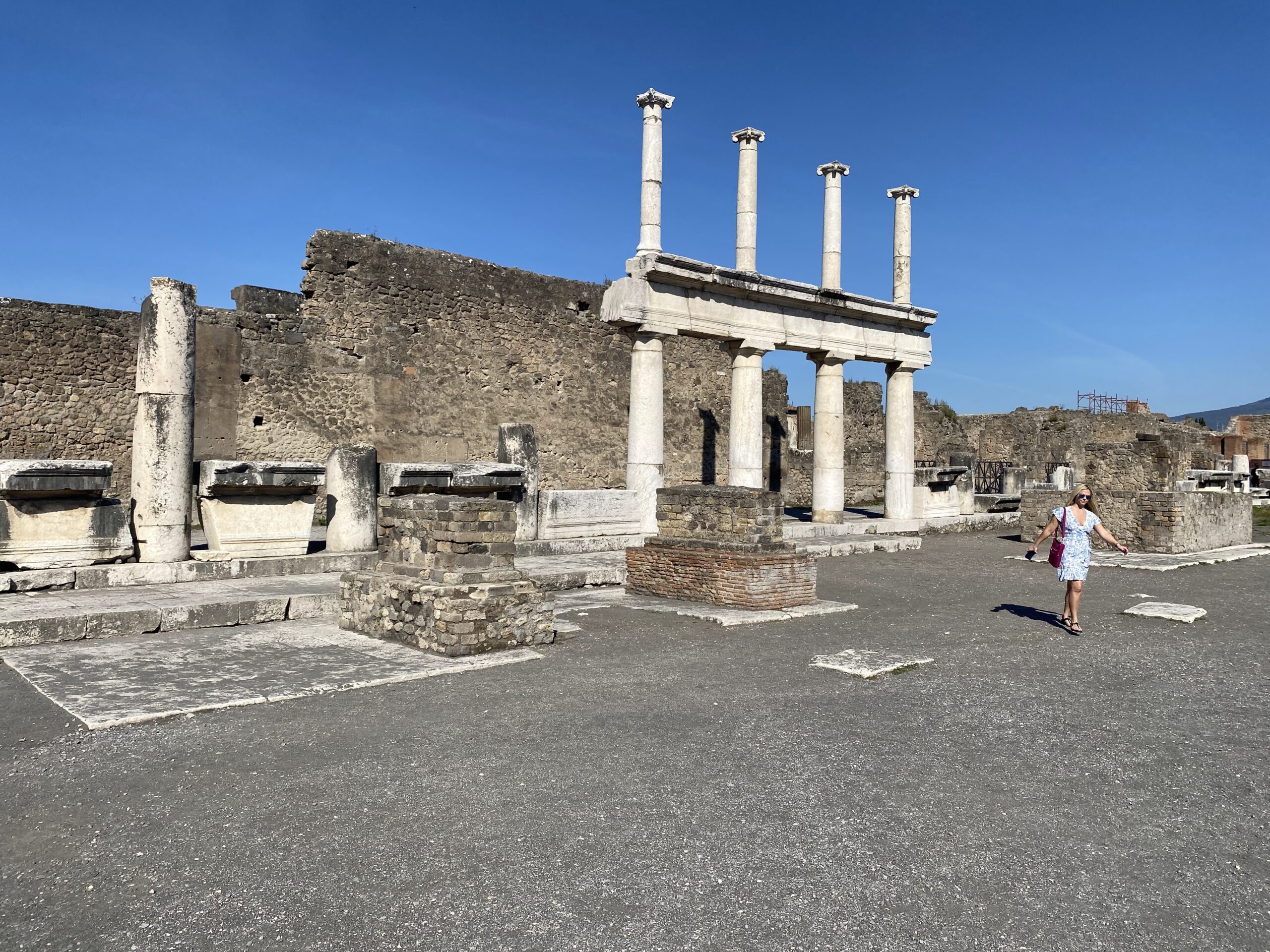Pompeii is an amazing archaeological site located near Naples in southern Italy. It was once a thriving Roman city until it was buried under ash and debris during the eruption of Mount Vesuvius in 79 AD.
How to get there
You can catch a train from Roma Termini, the central train station in Rome, to Naples Central. The journey takes around 1-2 hours, depending on the type of train you choose. You can check the schedule and book your ticket at www.trenitalia.com.
Once you arrive in Naples, you can transfer to the Circumvesuviana train line at Naples Garibaldi Station, which takes you directly to the Pompeii Scavi-Villa dei Misteri station, the closest station to the archaeological site. The journey from Naples to Pompeii takes approximately 30 minutes. From there, it’s a short walk to the entrance of the Pompeii ruins. You can check the schedule for Circumvesuviana trains here.
The Campania Express train costs $15 one way and $25 for a round trip. The fare was relatively high, but the transportation was comfortable, less crowded, and had fewer stops. Alternatively, you can opt for the local train, which costs $3.60 per trip.
Things to see in Pompeii
The entrance of Pompeii is a 5 min walk from the train station. The tickets cost $18. You can buy it in person or online. You can also include an audio guide for $8 or use a free Rick Steve guide or guided tours.

Forum
Begin your exploration at the Forum, the heart of the ancient city. This central square was Pompeii’s social, political, and economic hub. Marvel at the remains of temples, basilicas, and other essential structures that once surrounded the Forum.

Basilica
Pompeii’s basilica was used to carry out business and administer justice. It is accessed from the Forum through five entrances separated by tuff pillars.

Streets of Pompeii
They were made of large stone blocks and had raised sidewalks.

The main streets of Pompeii were lined with shops, taverns, and workshops, showcasing the city’s bustling trade and economic activity.

Houses of Pompeii
Discover the well-preserved houses of Pompeii, which provide a glimpse into the daily life of its inhabitants. Some notable homes include the House of the Faun, the House of the Vettii, and the House of the Tragic Poet. Admire the beautiful frescoes, intricate mosaics, and architectural details that have survived the test of time.
House of the Faun was one of the largest and most luxurious houses in Pompeii, featuring stunning mosaics and artworks.

House of the Vettii was a well-preserved Roman villa known for its beautiful frescoes and intricate interior design.

House of the Tragic Poet

The Bakery and Mill
The stone towers were the flour grinders where grain was ground into flour here, which was then used in the bakeries to make bread and other food items.

Theaters
Explore the theaters of Pompeii, including the large Theater and the smaller Odeon. Admire the architecture and acoustics of these ancient performance venues and envision the plays, musical performances, and public speeches that once took place here.

Baths of Pompeii
Explore the Baths of Pompeii, which were an integral part of Roman daily life. These public bathing complexes comprised various rooms, including hot baths, cold baths, and exercise areas.


Lupanar
Visit the Lupanar, the ancient brothel of Pompeii. Although a controversial site, it provides a unique glimpse into ancient Roman society’s social and cultural aspects.
It has a few cell-like bedrooms and beds and pillows made of stone.

The area where plaster casts of the eruption victims have been preserved. These haunting casts offer a poignant reminder of the tragic events that unfolded in Pompeii.

A poignant area where plaster casts of victims’ bodies are displayed, capturing the tragic human stories of the eruption.

You can explore the key attractions of Pompeii within 3-4 hours. Inside Pompeii, there is a cafeteria available, and you can also find some small shops outside where you can grab a light lunch or snacks. You can return to Naples in the afternoon by taking the Circumvesuviana train.
Things to do in Naples
Depending on your available time and interests, here are a few suggestions for places to visit in Naples.
National Archaeological Museum of Naples
The museum has a vast collection of ancient artifacts and artworks, including treasures from Pompeii and Herculaneum. It also houses sculptures, frescoes, mosaics, and the famous Farnese collection. We skipped it, but you can include it in your itinerary to learn about Pompeii. The tickets cost $22.
Piazza Municipio
The Municipal Square, known as the town hall square, is one of Naples’s most central squares.

A few cruise ships were docked at the port, and the area was bustling with activity and many people.

Castle Nuovo
Visit this medieval castle, Maschio Angioino, near the city’s harbor. Explore its courtyards, towers, and the Civic Museum, which houses a collection of medieval and Renaissance art.

Royal Palace of Naples
Step into the former residence of the Bourbon kings of Naples and marvel at its opulent interiors, lavish furnishings, and beautiful gardens. Don’t miss the magnificent Cappella Palatina and the Teatro di San Carlo, Europe’s oldest continuously active opera house.

Galleria Umberto
It is located directly across from the San Carlo opera house and is a public shopping gallery in Naples.

Naples Pizza
Enjoy a traditional Neapolitan pizza at one of the city’s many pizzerias.
In the evening, return to Rome using a High-Speed train or add more days in Naples to explore more.
How to get around Naples
Naples has an extensive public transportation system, including buses, trams, and the metro. These are convenient and affordable modes of transportation to explore the city. Taxis are also readily available throughout Naples. Many of Naples’ attractions are close to each other, making it a great city to explore on foot.
Let us know in the comment section below if you have any questions or suggestions.
